History of Arcerion: Difference between revisions
m Text replacement - "Category:2023 Award winning pages" to "{{Template:Award winning article}} Category:2023 Award winning pages" |
|||
| (24 intermediate revisions by 3 users not shown) | |||
| Line 1: | Line 1: | ||
[[File:Chester-on-Moore.jpg|thumb|Early artist rendition of Chester-on-Moore, c.1797 .]] | [[File:Chester-on-Moore.jpg|thumb|Early artist rendition of Chester-on-Moore, c.1797 .]] | ||
[[File:Governorates with Dates.png|thumb|Governorates of Arcerion with flags and the date they were Confederated into Arcerion as per Royal Decree. ]] | [[File:Governorates with Dates.png|thumb|Governorates of Arcerion with flags and the date they were Confederated into Arcerion as per Royal Decree. ]] | ||
The history of Arcerion began in the late eighteenth century with the settlement and establishment of | The history of Arcerion began in the late eighteenth century with the settlement and establishment of Ardmori colonies in the Southeastern Cronan Peninsula. The core territories of Arcerion's current sovereign borders would gradually expand until they reached their current state in 1975. Arcerion was predominantly settled | ||
== Prehistory == | == Prehistory == | ||
=== Indigenous Tribes === | === Indigenous Tribes === | ||
| Line 8: | Line 8: | ||
The dominant Northern Tribe was Chaxhan, which was considered culturally Lowland. They occupied the river basins and Arcer Heartland, and were the main opposition to Heartland settlements as settlers moved up the Innis and Leigh Rivers. They were also the main belligerent fighting against Arcerion during the Second Bush War, and participated to a limited extent supporting the Kel-kon'e in the Third Bush War. The Chaxhan were largely nomadic, with few to no permanent settlements in the Heartland, instead roving bands numbering between 50-500 indigenous people would move from location to location in accordance with season changes or based on decisions made by Tribal Chiefs and Tribal Elders. The Kel-kon'e and Tel-kon'e are two Northern Tribes that predominantly occupied the Northwestern Lowlands, in what would eventually become Oakham Governorate. They were semi-nomadic, with some settlements close to rivers and the Malentine Sea. The Tel-kon'e also had a limited ability to traverse open water and the littoral areas to the Malentine Islands, and occupied some of the Northern parts of Foxhey Governorate until they were forced to leave during the Third Bush War. | The dominant Northern Tribe was Chaxhan, which was considered culturally Lowland. They occupied the river basins and Arcer Heartland, and were the main opposition to Heartland settlements as settlers moved up the Innis and Leigh Rivers. They were also the main belligerent fighting against Arcerion during the Second Bush War, and participated to a limited extent supporting the Kel-kon'e in the Third Bush War. The Chaxhan were largely nomadic, with few to no permanent settlements in the Heartland, instead roving bands numbering between 50-500 indigenous people would move from location to location in accordance with season changes or based on decisions made by Tribal Chiefs and Tribal Elders. The Kel-kon'e and Tel-kon'e are two Northern Tribes that predominantly occupied the Northwestern Lowlands, in what would eventually become Oakham Governorate. They were semi-nomadic, with some settlements close to rivers and the Malentine Sea. The Tel-kon'e also had a limited ability to traverse open water and the littoral areas to the Malentine Islands, and occupied some of the Northern parts of Foxhey Governorate until they were forced to leave during the Third Bush War. | ||
==== Southern Tribes ==== | ==== Southern Tribes ==== | ||
[[File:Arcer Settlement Mainland.png|thumb|Major settlements and movement of colonists in Arcerion 1790-1904. ]] | |||
Southern Tribes are generally characterized by their semi-nomadic lifestyle, with a tendency to have several small-medium sized settlements of which the nomadic bands travelled through. The dominant force in this area was the A'awaska, who were the first tribe to come into contact with Carnish settlers. The A'waska consistently fought over a period of centuries the Tyrohsa, the main inland Southern Tribe, and to a lesser extent the Makalan. Both the A'awaska and the Makalan had written languages and some written texts, and possessed some forms of agriculture and a blended diet of both hunted and gathered sustenance as well as farm-grown vegetables. The Tyrohsa were entirely nomadic, relying on fishing in the McCallan River, and hunting the roving bands of deer and elk in the Arcer Heartland for sustenance. By the mid-1800s, the Tyrohsa had largely been driven out of the Southern portion of the Arcer Heartland, although during the Second Bush War, they were a main combatant in the Southeast. | Southern Tribes are generally characterized by their semi-nomadic lifestyle, with a tendency to have several small-medium sized settlements of which the nomadic bands travelled through. The dominant force in this area was the A'awaska, who were the first tribe to come into contact with Carnish settlers. The A'waska consistently fought over a period of centuries the Tyrohsa, the main inland Southern Tribe, and to a lesser extent the Makalan. Both the A'awaska and the Makalan had written languages and some written texts, and possessed some forms of agriculture and a blended diet of both hunted and gathered sustenance as well as farm-grown vegetables. The Tyrohsa were entirely nomadic, relying on fishing in the McCallan River, and hunting the roving bands of deer and elk in the Arcer Heartland for sustenance. By the mid-1800s, the Tyrohsa had largely been driven out of the Southern portion of the Arcer Heartland, although during the Second Bush War, they were a main combatant in the Southeast. | ||
== Early Colonial History (1790s-1880s) == | == Early Colonial History (1790s-1880s) == | ||
[[File:Arcer Expansion.png|thumb|Expansion of Arcer and Carnish Settlers into Crona. Carnish-led colonies marked with a red *, Arcer-led marked with a blue *. ]] | [[File:Arcer Expansion.png|thumb|Expansion of Arcer and Carnish Settlers into Crona. Carnish-led colonies marked with a red *, Arcer-led marked with a blue *. ]] | ||
=== | === Ardmori, '''Ænglis, and''' Gaelic Colonization === | ||
The | The Ardmori Crown made a decision in the late 1770s that it had to expand its colonial empire, and looked to the continent of Crona as a possible new venture. To this point, it was relatively untouched by most other Occidental nations, with only Kirav having begun to establish some colonies in [[Paulastra]] and [[The Cape]]. Finally, a decision was made in 1787 to begin forming an expedition. Prominent AEngle socialite and former infantry officer, John Farley Hughes was appointed as Chief of the Cronan Expedition for the Kingdom of Ardmore, and given an allotment of £10,000 to fund and prepare an expedition. Ardmore's naval service provided two frigates, the ''Chester'' and the ''Windswept'', and Hughes chose four larger two-masted Brigantines (''Nathaniel'', ''Sharp'', ''Rednose'', ''Bounty'') to carry the necessary supplies for a convoy. The six ships set sail in July of 1789, making a stop in [[Cartadania]] for supplies, before continuing the journey to Crona. The first sighting of the Cape of Crona was in of November of 1789, with the ships passing into the Songun Sea the same month. Up to this point, the relatively fair summer weather on the [[Odoneru Ocean]] had been fair to the expedition, and there had been minimal damage to both the ships and their crew. They initially anchored at one of Kirav's Paulastran ports, before carrying through a narrow strait in the Northern part of the Songun - the first Occidentals to enter the Sea. | ||
The Carnish AEngles and Gaels aboard Hughes' flotilla found a small bay, on the Eastern Coast of the [[Malentine Sea]], choosing it as the initial landing site for their colony due to its calm waters, and low rolling hills surrounding the colony. Hughes brought the ships close to shore, and on January 3rd, 1790 the first Occidental boots made landfall in what would become Arcerion. Foraging parties went forward and by late February small buildings, a jetty for small craft, and a small artillery revettment had been set up in the town. Initially, they named it for Hughes to honour his achievement, and Kurst was formerly known as "Hughton," or Hughes' Town. However, in April of 1790 a considerable portion of the settlement was burned down in a fire. Although the settlers rebuilt, they soon encountered their first Indigenous peoples. | The Carnish AEngles and Gaels aboard Hughes' flotilla found a small bay, on the Eastern Coast of the [[Malentine Sea]], choosing it as the initial landing site for their colony due to its calm waters, and low rolling hills surrounding the colony. Hughes brought the ships close to shore, and on January 3rd, 1790 the first Occidental boots made landfall in what would become Arcerion. Foraging parties went forward and by late February small buildings, a jetty for small craft, and a small artillery revettment had been set up in the town. Initially, they named it for Hughes to honour his achievement, and Kurst was formerly known as "Hughton," or Hughes' Town. However, in April of 1790 a considerable portion of the settlement was burned down in a fire. Although the settlers rebuilt, they soon encountered their first Indigenous peoples. | ||
Members of the A'awaska Tribe had previously been sighted fleetingly by members of the expedition when foraging or hunting inland, but no sustained contact was made. Then, in March of 1790, a sailor shot and killed an Indigenous man he found digging through his garden, killing him instantly. Not knowing what to do with the body, the | Members of the A'awaska Tribe had previously been sighted fleetingly by members of the expedition when foraging or hunting inland, but no sustained contact was made. Then, in March of 1790, a sailor shot and killed an Indigenous man he found digging through his garden, killing him instantly. Not knowing what to do with the body, the Ardmori settlers left the body on a small pile of rocks on the city outskirts, believing the locals would prefer to recover and bury their dead according to their own rituals. The Hughes' Expedition only religious representative, the Anglican, Deacon John Turnbull, even said last rites as per Ardmori tradition in case the A'awaska had no intention of reclamation. However the local Indigenous saw this as disrespect as they buried their dead much like Ardmori peoples, and took this to mean the people of Hughes' Town were disrespecting their dead. As such, not two weeks after the fire, they raided the small settlement, killing a dozen and wounding an equal amount of the settlers, who fled back to the jetty and the artillery revettment. Cannon fire and a concentrated effort from sailors, the ship's company of marines, and the local militia pushed back the Indigenous, who left a twenty or so dead or dying across the town before fleeing into the hills. This caused John Hughes to claim, "This damn land is cursed, first a fire? Then this? What a damned place Crona is." Over time, this name stuck to what would eventually become Arcerion's capital, and 'cursed' gradually transformed into 'Kurst,' the Gaelicized-version of the word. | ||
[[File:Arcerion Colonial Flag 1793.png|thumb|Flag for the Carnish Colony of Crona (proto-Arcerion), as delivered by the frigate ''Adventure'' in 1793. ]] | [[File:Arcerion Colonial Flag 1793.png|thumb|Flag for the Carnish Colony of Crona (proto-Arcerion), as delivered by the frigate ''Adventure'' in 1793. ]] | ||
By the end of 1790, John Hughes left Frederick Marlborough as the commander and governor of the small | By the end of 1790, John Hughes left Frederick Marlborough as the commander and governor of the small Ardmori colony. They had erected a small palisade and earth berms, and expanded the artillery revettment using spare four and six pound cannons from the frigates. Hughes set sail in the ''Windswept,'' with the ''Rednose'' following closely, bound for Ardmore to inform the King of the successful establishment of a Crown colony. | ||
Hughes informed the King of the success, and the Crown Royalty of | |||
Hughes informed the King of the success, and the Crown Royalty of Ardmore was overjoyed. They demanded an immediate follow-up expedition, with a dozen more ships packed with excited colonists to explore the new land. Most of these settlers were Ænglish and Gaelic, and this immigration trend would continue, giving Arcerion a dual cultural heritage. Hughes also travelled with a Royal Decree backdated for January 3rd, 1790 declaring the creation of the Ardmori Colony of Crona, and naming him Crown-Governor. Although he is the first Crown-Governor of Arcerion, in the recognized history by the Confederate Parliament, Frederick Marlborough is the first head-of-government in Arcerion. Hughes would leave in late 1791 with a second flotilla of a fourteen ships, including ''Windswept'', and would return to the colony, first landing several ships at what he was bemused to learn was now no longer Hughes' Town, but 'Kurst.' He then took six ships, and landed three apiece along the Songun Shore of the colony to the South, one of these ships, ''Chester'', becoming fouled in rocks not far from a large stretch of moorland, which ironically became the settling place for the future bustling port city of Chester-on-Moore. The smaller port city to the South of this was also established, Port Hughes was settled, which Hughes joked finally gave his name some meaning on the continent. | |||
[[File:1793 Colonial Territory.png|thumb|Carnish Colony of Crona as of 1793. ]] | [[File:1793 Colonial Territory.png|thumb|Carnish Colony of Crona as of 1793. ]] | ||
By the eve of 1793, two major settlements, Kurst and Chester-on-Moore had been established, and multiple smaller homesteads and farms had begun to appear, with the new settlers taking to irrigating, tilling, and farming the land, and raising and breeding the livestock that had survived the journey from | By the eve of 1793, two major settlements, Kurst and Chester-on-Moore had been established, and multiple smaller homesteads and farms had begun to appear, with the new settlers taking to irrigating, tilling, and farming the land, and raising and breeding the livestock that had survived the journey from Ardmore. Unexpectedly, in the spring of 1793, more sails were spotted on the horizon from Port Hughes' small coastal battery, and they hailed them using signal flags. The ships were additional expeditionary and settlers sent by the Ardmori Crown, including 12 pounder guns, horses, gold pieces, and other necessary resources to establish a more permanent presence. The ships were divided, with a pair staying anchored off the coast of Port Hughes, and the remainder carrying on up the coast to Kurst. | ||
In Kurst, the Crown-Governer's mansion had begun the process of being constructed, as had Fort Ellis, named for one of the men killed in the initial A'awaska raid of 1790. With the arrival of additional ships, the growing colony now numbered well over a thousand, with Chester-on-Moore rivaling this. Construction on a larger jetty and berthing for ships was begun, and other key infrastructure such as windmills had undergone improvements since the initial once were built in 1790. Individual ships by themselves or in small groupings would arrive and deliver supplies and new settlers, and the small colony swelled. Kurst now had distinct districts and a bustling main road, including a pair of popular pubs, both served by the same brewery. Initial issues of governance meant that John Hughes had to spend less time on inland expeditions and hunting trips, and more time in the Crown-Governor's residence, dealing with daily issues of governance. In 1793 he also directed the establishment of the Arcerion Loyal Militia, to augment the company of marines from the | |||
=== First Bush War === | In Kurst, the Crown-Governer's mansion had begun the process of being constructed, as had Fort Ellis, named for one of the men killed in the initial A'awaska raid of 1790. With the arrival of additional ships, the growing colony now numbered well over a thousand, with Chester-on-Moore rivaling this. Construction on a larger jetty and berthing for ships was begun, and other key infrastructure such as windmills had undergone improvements since the initial once were built in 1790. Individual ships by themselves or in small groupings would arrive and deliver supplies and new settlers, and the small colony swelled. Kurst now had distinct districts and a bustling main road, including a pair of popular pubs, both served by the same brewery. Initial issues of governance meant that John Hughes had to spend less time on inland expeditions and hunting trips, and more time in the Crown-Governor's residence, dealing with daily issues of governance. In 1793 he also directed the establishment of the Arcerion Loyal Militia, to augment the company of marines from the Ardmori naval service. Hughes also began the process of organizing survey parties to go inland and map, chart, and catalogue the land. Plans were made to connect Kurst to Chester-on-Moore via road, and expand the amount of settlers immigrating to inland towns such as Bradford and Loughton. Plans were also made to attempt to explore North along the coast. While Hughes as Crown-Governor has authorized the ''Windswept'' and ''Nathaniel'' to conduct limited expeditions Northwards, he was leery of spreading their resources too thin while the colony was so small and vulnerable. It was also during this time that the Ardmori Colony of Crona was named Arcerion for first time. Sightings of a sea monster off the coast of Chester-on-Moore prompted the locals to call the land "''Ar''-''Ceirean,"'' which was reported to Crown-Governer Hughes, who believed that to be a fitting name for the foggy moorland they now set out to colonize. | ||
=== First Bush War (1794-1801) === | |||
''See: [[Arcer Bush Wars]]'' | ''See: [[Arcer Bush Wars]]'' | ||
The First Bush War helped to stabilize the growing Ardmori Colony by combatting warring tribes of indigenous peoples as they tried to destroy early Arcer and Ardmori settlers via a series of increasingly violent raids. Arcerion would repel major raids on almost all of its early settlements, and its caravans and dispersed settlers outside the protection of either the militia or the Royal Ardmori Army often were subjected the the horrors of the frontier. | |||
This period also saw the establishment of the first major roads in Arcerion, connecting Chester-on-Moore and Kurst, as well as the expansion of inland towns and cities into the foothills of the Aileach Mountains. Kurst had a fort established, and the Arcer Army was born out of a nascent militia. This also coincided with a second expedition to establish [[Kinnaird]], which would grow to become Arcerion's second biggest city. The peace treaties and armistice with native tribes proved to be ab equal diplomatic feat. As warring bands of natives and leadership changed with such regularity, Arcer diplomats and representatives of the Ardmori Crown came to the conclusion that there was to be no true peace in the land, as what worked for one Chieftain may not for the next. | |||
=== | By the end of the First Bush War, most of what is modern day Moorden Governorate had been established, with Kinnaird in the North and Port Hughes in the South. A fort in Kurst as well as a full Regiment of Regular Arcer troops represented that the young colony's bureaucracy and defenses were quick to build and adapt to the new environment. This, coupled with Arcerion being granted the status as a new nation, allowed for the establishment of [[Moorden Governorate]] in 1798, giving Arcerion its first province. | ||
=== Inland Expansion === | |||
[[File:Norham settlements.png|thumb|Establishment of towns with dates for Norham Governorate in the early 1800s. ]] | |||
With the conclusion of the war, the following decade was followed by a period of rapid growth up the Malentine Coast through Malakan territory. In Kurst, the Arcer Parliament had its first building begin construction in 1803, the stone walls going up down the road on Red Lion Street from the Crown Governor's Mansion. Hughes was replaced as the Crown-Governor in 1806, recalled to Ardmore for exemplary service. A recently arrived Ardmori businessman, Francis Smith-Bellings, was appointed by the Ardmori Crown to serve as the new Crown-Governor. Bellings' extensive shipbuilding and maritime commercial links with [[Burgundie]], as well as his previous service in the Royal Ardmori Household Cavalry made him an outstanding candidate for the role. He was considered by many to be well-humoured, and level-headed, with the expertise required of the role. As Crown-Governor, the Bellings toured the entirety of Moorden Governorate, from Port Hughes to Kinnaird, and at the end of 1807 convened the members of the Ardmori nobility in Arcerion, senior Arcer politicans and statesmen, as well as members of the Arcer garrison to plan for further expansions. | |||
Bellings proposed inland settlement on the other side of the Aileach Mountains, with the express intent of trying to push the remaining tribes of the Tyrohsa out of the Northern foothills of the Aileach Mountains. A series of caravans would be sent overland through mountain passes as Arcer citizens moved to establish new homesteads and towns on the other side of the traditional geographic buffer between Occidentals and Indigneous peoples. By 1815, most of the Aileach Basin was settled and large farms had begun to send their grain and other produce via new roads back to Chester-on-Moore, Kurst, and Kinnaird for consumption and export to the Old World. To the Northwest, Norham Governorate's expansion had continued at a rapid pace, with towns being established all the way to the border with the Tel-kon'e tribesmen across the Innis River, notably with the establishment of Dunborough in 1825. With Norham having a rising population, the Ardmori Crown had issued a decree granting it the status of another Governorate. This now required additional levels of supervision as the growing Arcer colony had two provinces so quickly. Bellings appointed two Lieutenant-Governors, Charles Sutton, a former Royal Engineer, as the first Lieutenant-Governor of Moorden in 1811, and the same year for Norham he appointed Lieutenant-Governor Henry T. Dixon, a large landowner, for Norham Governorate. Sutton took up residence in Kurst, sharing the Crown-Governor's residence, while Dixon moved his family from Maltby to Craigfearn, the largest town in Norham with several thousand colonists. | |||
By this period, some minor skirmishes with the Tyrohsa had occurred, but advances in roadworks, as well as the expansion of the Arcer Militia and the growth of the Arcer Army had meant that the Indigenous tribes had been driven further into their homeland, and farther away from their traditional tribal areas. This led to a clash with the Chaxhan tribe, as they defended their lands (North of the Upper Cochrane river) from the bands of Tyrohsa people venturing away from Arco settlement. | |||
[[File:Foxhey exploration.png|thumb|Ships of the 1819 settlement expedition explore the islands that would become [[Foxhey Governorate]], looking to land and settle. ]] | |||
The Ardmori Crown sponsored another expedition further into the Malentine, finding the Southern of Foxhey's two islands. This was followed with the reaction of the "Gibson Settlement" in 1822, which was eventually renamed Port Gibson, and with the town reaching a population of 2,500 less than two years later, it had ratified the early Arco constitutional documents, the Crown recognizing it as a Governorate in 1824. Bellings was quick to appoint Frederick Gibson as the Governorate's first Lieutenant-Governor. Port Gibson would become a major fishing, whaling, and shipbuilding town, and one of Arcerion's most important Western ports. By the mid-1820s, Dunborough had established into a large frontier town. A permanent garrison of several hundred regular and Arcer soldiers, as well as thousands of farmers, settlers, and traders had created a trading town that was a junction between Indigenous and Occidental. This was similar to Dalfearn, which was at the foremost border of the inland Arco territory. Dalfearn itself was still growing and being industrialized, and with only a small dirt road that was easily washed out, was removed from most Arco garrisons and assistance from the Ardmori Crown. | |||
Easthampton | The end of the period prior to the Second Bush War was the establishment of Easthampton as a mining town. Bellings had relinquished the Crown-Governorship in 1825, recalled to Ardmore by the Crown Regent for the purpose of becoming the first Ambassador from Arcerion to Ardmore, representing the increasingly important status of the nation. He was replaced by Lord Rowan Elliot, a landed noble from Ardmore and a sizeable landowner in South Moorden. Elliot's first aim was to expand to the Eastern reaches of the Arcer Heartland, the major key piece of this being a large minining expedition that would culminate with Easthampton's establishment in 1834 as Arcerion's Easternmost settlement. | ||
=== Second Bush War (1839-1850) === | |||
[[File:Inland Expansion of Arcerion.png|thumb|Late 1830s caravan settlement directions as part of inland expansion. ]] | |||
By the outbreak of the Second Bush War, Moorden Governorate was a fully functioning proto-state. It had departments, bureaucracy, and taxation, with shipyards, docks, and wharfs seeing an exponential increase in emigration and commerce month by month. Norham and Foxhey Governorates also had begun to see an increase in the apparatus of the state, and Arcerion's growth and future outlook were positive. | |||
Inland expansion was done via caravans, large groups of several hundred settlers that would take wagons, horses, cattle, and supplies to unsettled lands and attempt to set up new towns and farms to continue to push Arcerion's boundaries. This finally clashed with the Chaxhan tribe, who controlled much of the territory in the Innis River Basin, along the Leigh River, and the area north of the Cochrane River. The remnants of the Chaxhan and Tyrohsa tribes declared a truce and banded together as allies to combat Arcer settlers, raiding and destroying many caravans in the first year of the conflict. The response by Crown-Governor Sir Franklin Wright was to deploy the Army inland in force, to begin counter-raiding, patrolling, and conducting large sweep and clearance operations to force Indigenous tribes out of the new settlement areas. | |||
Initially, the war was inconclusive, as the Allied Tribes withdrew deeper to avoid a large defeat due to their dwindling numbers, as their population's decline had been hastened by interaction with Occidentals and their low resistance to Occidental diseases. Minor gains were made initially, with the [[Royal Arcerion Regiment]] moving its battalions to Dalfearn to begin operations there. Wright also sought a royal decree, and was permitted to raise additional regiments by either reconstituting militia units as Regular Army formations, or the creation of new ones (notably the [[Royal Moorden Regiment]] in 1849 and the [[Northlea Rifle Regiment]] in 1842). | |||
War is | By the end of 1847, reconnaissance by Arco and Ardmori cavalry scouts had made it clear that the Allied Warbands had finished their scouting and raids. Raids along the river had created issues for settlements that were unable to defend themselves, and a series of forts and block houses were constructed between 1845-1848, under the direction of Sir Wright, and by doing so the Allied Indigenous tribes were forced to withdraw further, preventing them from striking deeper into Norham and Moorden governorates. This, combined with armed riverboats and early gunboats, allowed for the quicker transportation of men, weapons, and equipment up the Innis, Leigh, and Cochrane rivers to reinforce major garrisons such as Dalfearn. In the Innis River Basin, the Battle of Dunborough in 1847 by the Northlea Rifle Regiment had destroyed a large Chaxhan warband, and forced them to flee. In pursuit, two battalions of the Northlea Rifle Regiment were trapped and surrounded at Gordon's Farm. Numbering 644 men, the Arcer soldiers defended themselves against War Chieftain Ylo M-K'ahsa, and what is estimated to be over 4,000 Chaxhan warriors at the Battle of Gordon Farm. Surrounded for three days and without relief, until a reinforced battalion from the Royal Arcerion Regiment made it to the battlefield. It would be a pivotal moment in Arcer history, as it was a display of [[Arco Determinism]]. | ||
[[File:Battle of Gordon's Farm.png|thumb|Members of the Northlea Rifle Regiment tend to wounded and defend their position at the Battle of Gordon's Farm in an oil painting by Hugo Davidson. ]] | |||
In 1848, a warband of nearly 10,000 Chaxhan warriors descended on Easthampton, and the Royal Arcerion Regiment defended the mining town for over a week, with fierce urban battles and counter-attacks in the mountains occurring. The battle ended in a stalemate however Arco forces held the town and forced a Chaxhan withdrawal, ultimately meaning it was a strategic Arcer victory with Easthampton's survival. 1849 and 1850 saw large clashes between Chaxhan Warbands and Ardmori and Arco regular troops. Along the length of the Upper Cochrane River, the [[River Campaign]] saw large clashes between the 14th, 15th, 77th, 81st, and 92nd Regiments of the Foot (Ardmori Army), with support from the Royal Arcerion Regiment, Royal Moorden Regiment (formerly the Arcerion Loyal Militia), and elements of the Northlea Rifle Regiment. Two major battles were fought, resulting in thousands of Indigenous warriors killed, and several hundred of the Royal forces. | |||
In the rear areas, the newly formed Royal Arcerion Constabulary, a paramilitary gendarmerie, was working to investigate smaller raids and thefts, and detain and prosecute smaller warbands of indigenous warriors harassing the populace. This was done under the new Crown Governor, appointed in 1849, and the first natural-born Arcer, Sir George Greene. A career farmer and agricultural businessman, Greene had also served briefly as an officer in the Militia, before resigning his commission to serve as the head of the Arcer Treasury in 1833. Greene would see the Second Bush War through to its end. The war ended shortly after the fourth and final Battle of Cochrane River, where the remaining Chaxhan and Tyrohsa forces were destroyed by the Royal Army, and their war chieftains commited riutal suicide, the new leaders suing for peace and withdrawing their remaining tribes and peoples to the Northern reaches of the Arcer Heartland, in the foothills of the Northumbraeland mountains. | |||
== Late Colonial History (1880s-1920s) == | |||
=== Antebellum Period and Economic Boom (1851-1886) === | |||
[[File:Northlea Barn construction.png|thumb|A barn is raised in Northlea Governorate in 1859.]] | |||
With the conclusion of the Second Bush War, Arcerion had for a second time defended its existence from marauders that had sought to destroy it. This coincided with a decree from the Ardmori Crown establishing Northlea Governorate as Arcerion's fourth province, and the newly arrived Lieutenant-Governor Lord David Barclay appointed by the Crown as its governor. This was a break from convention, as it was unusual for a Lieutenant-Governor not to be recommended by the Crown-Governor, and instead reflected an increasing mistrust of Arcerion's growing levels of independence. | |||
Despite this, the Ardmori Crown continued to grant increasing levels of economic freedom to Arcerion, including the issuing of its own bonds, the creation of its own tax law, as well as allowing some autonomy for the Governorates to create their own legislation at the provincial level. However, Ardmore retained tight control over the federal organs of power, to ensure the colony did not stray away from the Crown. Despite this, Arcerion's booming economy was reflected by the massive increase in shipping to its Southern ports, a heavy increase in trade with Paulastra, and the continual arrival of new Ængles, Gaels, and Gothic peoples who sought a new life and a parcel of land to farm as part of a great migration from Levantia. | |||
During this time Arcerion's population reached over fifteen million. The economy had already outstripped the native Indigenous states, and was rivalled only in South Crona by other Occidental nations such as Alstin and Paulastra. Major exports of wheat, soft and hardwood timber, rye, and spirits helped flood foreign markets with increasing numbers of Arco goods. Discussions even began surrounding the creation of a new Arcer currency. | |||
[[File:Oakham caravan.png|thumb|A caravan from Oakham is greeted by other settlers as it forays into the Arcer Heartland along the North Innis River, 1870. ]] | |||
This period was mostly known for the settlement of the [[Arcer Heartland]]. Caravans in 1864 and 1870 moved inland along the Leigh and Innis Rivers, pushing forward from Oakham (established in 1839) and Dalfearn. By 1878, the largest Arcer settlement in the Heartland, Presdale, had been established by a group of Gaels resettled from North Ardmore, and Arcerion's footprint in the Heartland was established. By 1888, a caravan from Oakham had Pushed along the North Innis, establishing contact formally for the first time with the Kel-kon'e tribe, who now had been forced to share lands with the Chaxhan tribesemen who ahd continued their withdrawal Northwards each successive generation. Arcer culture had also taken major leaps with the establishment of a nascent national identity, later formalized as Arco Determinism. Folk music, newspapers, parades, and national holidays had begun to take root, and Ængle and Gael traditions mixed with those of the established Arcer citizenry to create a blended national identity. Even the Ænglish language had begun to change with regional dialects in Foxhey and Moorden giving a different accent that was distinctly different from Levantine Ængles. | |||
=== Industrialization and railways (1886-1898) === | |||
With the introduction of the [[Arco National Railway Service]] (ANRS) the pace of industrialization in Arcerion increased rapidly. The first rail line was set from Port Hughes in the South to Dunborough in the North, with a new line set up to Easthampton to help ship the vast quantities of iron ore and steel products being manufactured in the town. It was during this time of rapid economic expansion and mass emigration that Crown Governor Sir William Walter James requested permission on Arcerion's centennial birthday to have a special status as a semi-sovereign state. Granted by the Crown Regent in Ardmore, this gave Arcerion control over its own international relations, diplomatic presence, its own sovereign coat of arms, and control over its economic policy. This petition formed the second of three documents that formed the basis for the Arcer constitution. | |||
[[File:Parliament reconstruction Arcerion.png|thumb|Additional construction of the Confederate Parliament in the 1890s with the expansion of Arcerion as a semi-sovereign state. ]] | |||
With semi-governance also came the withdrawal of much of the regular Ardmori forces. Multiple regiments of infantry, cavalry, and batteries of artillery were withdrawn, as well as the offices and officers of the Ardmori Crown such as the Crown Treasurer to Arcerion, the Tariff Office, and the Attorney General for Arcerion. In the wake of the Ardmori withdrawal in 1890, Arcer Crown Governor Sir James relinquished his role in a ceremony to Henry Faulkner, a Lord and shipbuilding magnate from Foxhey, a born citizen of Arcerion. James' reasoning was Arcerion now must be ruled by its own people, and Faulkner was the first Crown Governor from Foxhey, and the second naturally-born Arcer to hold the office. | |||
The Confederate Parliament by this time had expanded into a full legislature, and provisions to move the Arcer Senate into a new wing of the building had coincided with planned improvements and upgrades for the building. Rosmore Station in Kurst, the largest railway station and trainyard was seeing daily regular traffic in the thousands, and major corporations from [[Arcerion Steel Corporation|Arco Steel]] to Foxhey Shipyards were quickly competing at an international level and establishing Arceiron as the dominant Malentine economic power. Proto-states in [[Kelekona]], [[Titechaxha]], and [[Istrenya]] were increasingly becoming reliant on Arco trade, and the wharfs and dockyards of Chester-on-Moore and Kurst were overflowing with Levantine ships, especially those of Burgundie, transporting Arcer goods to the Occidental world. However relations with Paulastra, especially concerning the Washakaran Basin, were beginning to cloud over. Diplomatic negotiations over the administration of the small native reserve was increasingly declining, and the strained diplomatic relationship was further damaged with the introduction of the Arcer Pound in 1890, which quickly flooded the Washakaran market, devaluing Paulastran currency and further bringing Washakara closer to Arcerion. | |||
Industrialization in Arcerion varied greatly by Governorate and type. In Moorden, developed factories, manufacturing plants, and raw mineral and mining industries (especially in Easthampton) were the largest shares of the market. Conversely, Northlea and Norham remained mostly agrarian in nature, with grain, rye, and maize increasing in production due to advances in new crop rotation methods, advanced farming machinery, and the creation of grain coops where farmers pooled resources and financed grain elevators and shipping techniques via rail. Foxhey remained largely reliant on maritime sources of economic prosperity such as fishing and ship building, however the federal contracts for the [[Royal Arcerion Naval Service]] meant that hundreds of jobs were created with the plans to construct new frigates, ships of the line, and the planned introduction of steam vessels. | |||
[[File:Shipbuilding in Foxhey.png|thumb|Shipyards in Port Gibson, Foxhey during the late 19th century saw a boom with the increase in the maritime commerce in the Malentine Sea requiring additional ships to carry the exponential increase in tonnage. ]] | |||
Royal Arcerion | === Third Bush War (1898-1904) === | ||
== | RAR battle | ||
=== First Great War === | === First Great War === | ||
=== The Arcer Heartland === | ''See: [[Washakaran Campaign]]'' | ||
=== [[Arcer Heartland|The Arcer Heartland]] === | |||
== Early 20th Century == | == Early 20th Century == | ||
=== [[Ardmori Civil War]] === | |||
=== Second Great War === | === Second Great War === | ||
''See: [[Cronan Theatre of the Second Great War]]'' | |||
=== Last Bastion of Royal | === Last Bastion of Royal Ardmore === | ||
Ardmori diaspora and the great resettlement | |||
== Late 20th Century == | == Late 20th Century == | ||
=== Fourth Bush War === | === Fourth Bush War === | ||
| Line 76: | Line 98: | ||
=== Economic Growth and Polynesian Initiatives === | === Economic Growth and Polynesian Initiatives === | ||
== All Old/Partially Canonical == | == All Old/Partially Canonical == | ||
Arcerion was first settled by early | Arcerion was first settled by early Ardmori populations in the 1790s, becoming a recognized and organized colony in the [[Kingdom of Carna]] in 1793. In the period that followed, Kurst, Kinnaird, and Chester-on-Moore all grew into prosperous colonial towns, providing jobs and stability in a region that was noted for its shifting political states and reliability of colonial partners. Arco settlers spread quickly to what would become the rolling plains of Northlea governate, taking their pluck and knack for farming and creating vast farming estates, helping to boost the early colony's independence on foreign foodstuffs and goods by increasing tis self-reliance. By the 1830s, expansion into the mountains had begun, and the small mining town of Easthampton had discovered the resources that would help solidify Moorden's future as a raw ore and industrial processing center in Crona. Gained economic and interior governance independence in the 1880s. Full independence just before the Great War. A series of [[Arcer Bush Wars|border skirmishes]] with their indigenous neighbours to the North would be a constant, with Arco militia forces taking over the bulk of the country's policing and security operations by the 1860s. Carnish influence continued to exist in the capital, and Arco settlers still proudly identified their loyalty to the crown and identified as citizens of Carna until they were granted self-rule and governance in 1886. By this time, there was only token presence of Carnish tax inspectors, administrators, and politicians, with the vast majority of government positions having been taken over by Arcer citizens. It was roughly this time that Carna began to permit the issuance of passport-equivalent paperwork and allowed Arcerion to have its own self-determined foreign policy, beginning with the fledgling emergence of Arcerion's Foreign Office, which first began as the Foreign Secretary and their staff. | ||
Self governance brought its own series of challenges as Arcerion grappled with instituting its own public services and administrations. Arcerion specifically focused on the overhaul of its Parliament, resulting in the legislature moving away from a colonial model to a two-tiered system with an upper and lower house. By moving the lower-house to the Provincial/Governate level, the hope was that the creep of federal power would not detract from the Confederation as a whole. The result was a decentralized approach to governance allowed for individual governates to grow, with the assurance that the collective would support in times of need. By the late 1890s, increased [[Arcer Bush Wars|border skirmishes]] required the country's first 'sovereign' or 'independent' deployment of military forces to Northlea and what was then-Northlea's Western portions, and what would eventually become Oakham governate. Multiple Arcer infantry, cavalry, and the first light artillery formations were sent North to combat the growing restlessness of indigenous populations who had begun to attack and murder families of Arcer farmers as they ventured out into the Cronan wilds to stake their claim. This period, [[The Border Wars]], would help form part of modern (2000s) Arco policy towards Kelekona and Titechaxha, wherein the borders are rigorously patrolled and monitored. | Self governance brought its own series of challenges as Arcerion grappled with instituting its own public services and administrations. Arcerion specifically focused on the overhaul of its Parliament, resulting in the legislature moving away from a colonial model to a two-tiered system with an upper and lower house. By moving the lower-house to the Provincial/Governate level, the hope was that the creep of federal power would not detract from the Confederation as a whole. The result was a decentralized approach to governance allowed for individual governates to grow, with the assurance that the collective would support in times of need. By the late 1890s, increased [[Arcer Bush Wars|border skirmishes]] required the country's first 'sovereign' or 'independent' deployment of military forces to Northlea and what was then-Northlea's Western portions, and what would eventually become Oakham governate. Multiple Arcer infantry, cavalry, and the first light artillery formations were sent North to combat the growing restlessness of indigenous populations who had begun to attack and murder families of Arcer farmers as they ventured out into the Cronan wilds to stake their claim. This period, [[The Border Wars]], would help form part of modern (2000s) Arco policy towards Kelekona and Titechaxha, wherein the borders are rigorously patrolled and monitored. | ||
| Line 83: | Line 105: | ||
As the decades continued the economy continued to grow, with Moorden's raw iron ore exports shipped through the Songun Straits out to the old world, and Arcer foodstuffs from Northlea governate slowly becoming more prevalent in markets and groceries through Southern Crona. Roads and rail systems began to be created under new infrastructure projects, as early politicians used the limited federal taxes and income to benefit the average Arco citizen. The establishment of the [[Arco National Railway Service]] (ANRS) in 1886 resulted in the nation's first heavy commercial rail line from the Kinnaird-Kurst areas to Easthampton to carry raw resources to ports for transport to manufacturing facilities abroad. | As the decades continued the economy continued to grow, with Moorden's raw iron ore exports shipped through the Songun Straits out to the old world, and Arcer foodstuffs from Northlea governate slowly becoming more prevalent in markets and groceries through Southern Crona. Roads and rail systems began to be created under new infrastructure projects, as early politicians used the limited federal taxes and income to benefit the average Arco citizen. The establishment of the [[Arco National Railway Service]] (ANRS) in 1886 resulted in the nation's first heavy commercial rail line from the Kinnaird-Kurst areas to Easthampton to carry raw resources to ports for transport to manufacturing facilities abroad. | ||
[[Category:Arcerion]] | [[Category:Arcerion]] | ||
[[Category:History]] | |||
[[Category:IXWB]] | |||
[[Category:Arcer History]] | |||
{{Template:Award winning article}} | |||
[[Category:2023 Award winning pages]] | |||
Latest revision as of 10:22, 10 August 2023
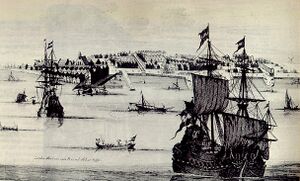
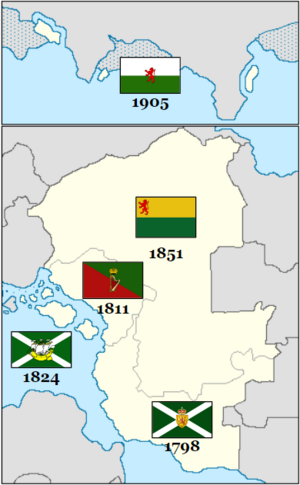
The history of Arcerion began in the late eighteenth century with the settlement and establishment of Ardmori colonies in the Southeastern Cronan Peninsula. The core territories of Arcerion's current sovereign borders would gradually expand until they reached their current state in 1975. Arcerion was predominantly settled
Prehistory
Indigenous Tribes
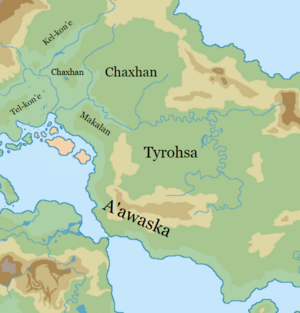
The indigenous tribes of Arcerion had been native to Crona for centuries prior to Occidental colonization. They were organized around small, multi-family bands that lived nomadic or semi-nomadic lifestyles, with limited access to Occidental-style agriculture or livestock. Culture and heritage were usually passed down orally, although some tribes such as the Makalan had limited written language texts as found in their abandoned camps. The tribes also were in a constant state of conflict, fighting each other over border issues or existing historical rivalry and feuds. In the Arcer Lowlands to the South, the A'awaska were the most dominant, living in small longhouses and with some earthen shelters in more permanent settlements. This represented a key difference between them and the Northern Tribes, who were more nomadic. In general, Arcer and Cronan historians have separated the tribes into two main geographic groups, the Northern and Southern Tribes, and within that they are separated into Highland and Lowland cultural tradition.
Northern Tribes
The dominant Northern Tribe was Chaxhan, which was considered culturally Lowland. They occupied the river basins and Arcer Heartland, and were the main opposition to Heartland settlements as settlers moved up the Innis and Leigh Rivers. They were also the main belligerent fighting against Arcerion during the Second Bush War, and participated to a limited extent supporting the Kel-kon'e in the Third Bush War. The Chaxhan were largely nomadic, with few to no permanent settlements in the Heartland, instead roving bands numbering between 50-500 indigenous people would move from location to location in accordance with season changes or based on decisions made by Tribal Chiefs and Tribal Elders. The Kel-kon'e and Tel-kon'e are two Northern Tribes that predominantly occupied the Northwestern Lowlands, in what would eventually become Oakham Governorate. They were semi-nomadic, with some settlements close to rivers and the Malentine Sea. The Tel-kon'e also had a limited ability to traverse open water and the littoral areas to the Malentine Islands, and occupied some of the Northern parts of Foxhey Governorate until they were forced to leave during the Third Bush War.
Southern Tribes

Southern Tribes are generally characterized by their semi-nomadic lifestyle, with a tendency to have several small-medium sized settlements of which the nomadic bands travelled through. The dominant force in this area was the A'awaska, who were the first tribe to come into contact with Carnish settlers. The A'waska consistently fought over a period of centuries the Tyrohsa, the main inland Southern Tribe, and to a lesser extent the Makalan. Both the A'awaska and the Makalan had written languages and some written texts, and possessed some forms of agriculture and a blended diet of both hunted and gathered sustenance as well as farm-grown vegetables. The Tyrohsa were entirely nomadic, relying on fishing in the McCallan River, and hunting the roving bands of deer and elk in the Arcer Heartland for sustenance. By the mid-1800s, the Tyrohsa had largely been driven out of the Southern portion of the Arcer Heartland, although during the Second Bush War, they were a main combatant in the Southeast.
Early Colonial History (1790s-1880s)
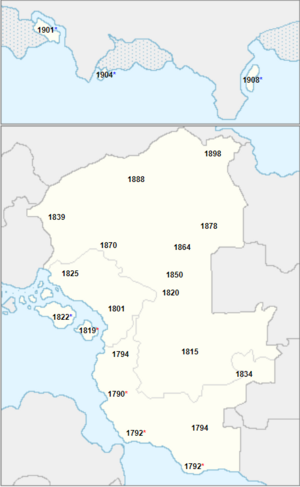
Ardmori, Ænglis, and Gaelic Colonization
The Ardmori Crown made a decision in the late 1770s that it had to expand its colonial empire, and looked to the continent of Crona as a possible new venture. To this point, it was relatively untouched by most other Occidental nations, with only Kirav having begun to establish some colonies in Paulastra and The Cape. Finally, a decision was made in 1787 to begin forming an expedition. Prominent AEngle socialite and former infantry officer, John Farley Hughes was appointed as Chief of the Cronan Expedition for the Kingdom of Ardmore, and given an allotment of £10,000 to fund and prepare an expedition. Ardmore's naval service provided two frigates, the Chester and the Windswept, and Hughes chose four larger two-masted Brigantines (Nathaniel, Sharp, Rednose, Bounty) to carry the necessary supplies for a convoy. The six ships set sail in July of 1789, making a stop in Cartadania for supplies, before continuing the journey to Crona. The first sighting of the Cape of Crona was in of November of 1789, with the ships passing into the Songun Sea the same month. Up to this point, the relatively fair summer weather on the Odoneru Ocean had been fair to the expedition, and there had been minimal damage to both the ships and their crew. They initially anchored at one of Kirav's Paulastran ports, before carrying through a narrow strait in the Northern part of the Songun - the first Occidentals to enter the Sea.
The Carnish AEngles and Gaels aboard Hughes' flotilla found a small bay, on the Eastern Coast of the Malentine Sea, choosing it as the initial landing site for their colony due to its calm waters, and low rolling hills surrounding the colony. Hughes brought the ships close to shore, and on January 3rd, 1790 the first Occidental boots made landfall in what would become Arcerion. Foraging parties went forward and by late February small buildings, a jetty for small craft, and a small artillery revettment had been set up in the town. Initially, they named it for Hughes to honour his achievement, and Kurst was formerly known as "Hughton," or Hughes' Town. However, in April of 1790 a considerable portion of the settlement was burned down in a fire. Although the settlers rebuilt, they soon encountered their first Indigenous peoples. Members of the A'awaska Tribe had previously been sighted fleetingly by members of the expedition when foraging or hunting inland, but no sustained contact was made. Then, in March of 1790, a sailor shot and killed an Indigenous man he found digging through his garden, killing him instantly. Not knowing what to do with the body, the Ardmori settlers left the body on a small pile of rocks on the city outskirts, believing the locals would prefer to recover and bury their dead according to their own rituals. The Hughes' Expedition only religious representative, the Anglican, Deacon John Turnbull, even said last rites as per Ardmori tradition in case the A'awaska had no intention of reclamation. However the local Indigenous saw this as disrespect as they buried their dead much like Ardmori peoples, and took this to mean the people of Hughes' Town were disrespecting their dead. As such, not two weeks after the fire, they raided the small settlement, killing a dozen and wounding an equal amount of the settlers, who fled back to the jetty and the artillery revettment. Cannon fire and a concentrated effort from sailors, the ship's company of marines, and the local militia pushed back the Indigenous, who left a twenty or so dead or dying across the town before fleeing into the hills. This caused John Hughes to claim, "This damn land is cursed, first a fire? Then this? What a damned place Crona is." Over time, this name stuck to what would eventually become Arcerion's capital, and 'cursed' gradually transformed into 'Kurst,' the Gaelicized-version of the word.
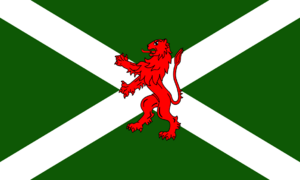
By the end of 1790, John Hughes left Frederick Marlborough as the commander and governor of the small Ardmori colony. They had erected a small palisade and earth berms, and expanded the artillery revettment using spare four and six pound cannons from the frigates. Hughes set sail in the Windswept, with the Rednose following closely, bound for Ardmore to inform the King of the successful establishment of a Crown colony.
Hughes informed the King of the success, and the Crown Royalty of Ardmore was overjoyed. They demanded an immediate follow-up expedition, with a dozen more ships packed with excited colonists to explore the new land. Most of these settlers were Ænglish and Gaelic, and this immigration trend would continue, giving Arcerion a dual cultural heritage. Hughes also travelled with a Royal Decree backdated for January 3rd, 1790 declaring the creation of the Ardmori Colony of Crona, and naming him Crown-Governor. Although he is the first Crown-Governor of Arcerion, in the recognized history by the Confederate Parliament, Frederick Marlborough is the first head-of-government in Arcerion. Hughes would leave in late 1791 with a second flotilla of a fourteen ships, including Windswept, and would return to the colony, first landing several ships at what he was bemused to learn was now no longer Hughes' Town, but 'Kurst.' He then took six ships, and landed three apiece along the Songun Shore of the colony to the South, one of these ships, Chester, becoming fouled in rocks not far from a large stretch of moorland, which ironically became the settling place for the future bustling port city of Chester-on-Moore. The smaller port city to the South of this was also established, Port Hughes was settled, which Hughes joked finally gave his name some meaning on the continent.
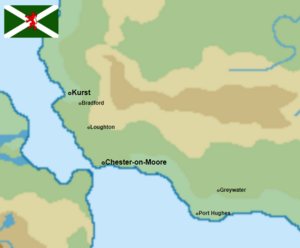
By the eve of 1793, two major settlements, Kurst and Chester-on-Moore had been established, and multiple smaller homesteads and farms had begun to appear, with the new settlers taking to irrigating, tilling, and farming the land, and raising and breeding the livestock that had survived the journey from Ardmore. Unexpectedly, in the spring of 1793, more sails were spotted on the horizon from Port Hughes' small coastal battery, and they hailed them using signal flags. The ships were additional expeditionary and settlers sent by the Ardmori Crown, including 12 pounder guns, horses, gold pieces, and other necessary resources to establish a more permanent presence. The ships were divided, with a pair staying anchored off the coast of Port Hughes, and the remainder carrying on up the coast to Kurst.
In Kurst, the Crown-Governer's mansion had begun the process of being constructed, as had Fort Ellis, named for one of the men killed in the initial A'awaska raid of 1790. With the arrival of additional ships, the growing colony now numbered well over a thousand, with Chester-on-Moore rivaling this. Construction on a larger jetty and berthing for ships was begun, and other key infrastructure such as windmills had undergone improvements since the initial once were built in 1790. Individual ships by themselves or in small groupings would arrive and deliver supplies and new settlers, and the small colony swelled. Kurst now had distinct districts and a bustling main road, including a pair of popular pubs, both served by the same brewery. Initial issues of governance meant that John Hughes had to spend less time on inland expeditions and hunting trips, and more time in the Crown-Governor's residence, dealing with daily issues of governance. In 1793 he also directed the establishment of the Arcerion Loyal Militia, to augment the company of marines from the Ardmori naval service. Hughes also began the process of organizing survey parties to go inland and map, chart, and catalogue the land. Plans were made to connect Kurst to Chester-on-Moore via road, and expand the amount of settlers immigrating to inland towns such as Bradford and Loughton. Plans were also made to attempt to explore North along the coast. While Hughes as Crown-Governor has authorized the Windswept and Nathaniel to conduct limited expeditions Northwards, he was leery of spreading their resources too thin while the colony was so small and vulnerable. It was also during this time that the Ardmori Colony of Crona was named Arcerion for first time. Sightings of a sea monster off the coast of Chester-on-Moore prompted the locals to call the land "Ar-Ceirean," which was reported to Crown-Governer Hughes, who believed that to be a fitting name for the foggy moorland they now set out to colonize.
First Bush War (1794-1801)
See: Arcer Bush Wars
The First Bush War helped to stabilize the growing Ardmori Colony by combatting warring tribes of indigenous peoples as they tried to destroy early Arcer and Ardmori settlers via a series of increasingly violent raids. Arcerion would repel major raids on almost all of its early settlements, and its caravans and dispersed settlers outside the protection of either the militia or the Royal Ardmori Army often were subjected the the horrors of the frontier.
This period also saw the establishment of the first major roads in Arcerion, connecting Chester-on-Moore and Kurst, as well as the expansion of inland towns and cities into the foothills of the Aileach Mountains. Kurst had a fort established, and the Arcer Army was born out of a nascent militia. This also coincided with a second expedition to establish Kinnaird, which would grow to become Arcerion's second biggest city. The peace treaties and armistice with native tribes proved to be ab equal diplomatic feat. As warring bands of natives and leadership changed with such regularity, Arcer diplomats and representatives of the Ardmori Crown came to the conclusion that there was to be no true peace in the land, as what worked for one Chieftain may not for the next.
By the end of the First Bush War, most of what is modern day Moorden Governorate had been established, with Kinnaird in the North and Port Hughes in the South. A fort in Kurst as well as a full Regiment of Regular Arcer troops represented that the young colony's bureaucracy and defenses were quick to build and adapt to the new environment. This, coupled with Arcerion being granted the status as a new nation, allowed for the establishment of Moorden Governorate in 1798, giving Arcerion its first province.
Inland Expansion
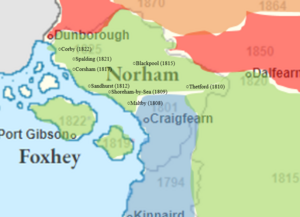
With the conclusion of the war, the following decade was followed by a period of rapid growth up the Malentine Coast through Malakan territory. In Kurst, the Arcer Parliament had its first building begin construction in 1803, the stone walls going up down the road on Red Lion Street from the Crown Governor's Mansion. Hughes was replaced as the Crown-Governor in 1806, recalled to Ardmore for exemplary service. A recently arrived Ardmori businessman, Francis Smith-Bellings, was appointed by the Ardmori Crown to serve as the new Crown-Governor. Bellings' extensive shipbuilding and maritime commercial links with Burgundie, as well as his previous service in the Royal Ardmori Household Cavalry made him an outstanding candidate for the role. He was considered by many to be well-humoured, and level-headed, with the expertise required of the role. As Crown-Governor, the Bellings toured the entirety of Moorden Governorate, from Port Hughes to Kinnaird, and at the end of 1807 convened the members of the Ardmori nobility in Arcerion, senior Arcer politicans and statesmen, as well as members of the Arcer garrison to plan for further expansions.
Bellings proposed inland settlement on the other side of the Aileach Mountains, with the express intent of trying to push the remaining tribes of the Tyrohsa out of the Northern foothills of the Aileach Mountains. A series of caravans would be sent overland through mountain passes as Arcer citizens moved to establish new homesteads and towns on the other side of the traditional geographic buffer between Occidentals and Indigneous peoples. By 1815, most of the Aileach Basin was settled and large farms had begun to send their grain and other produce via new roads back to Chester-on-Moore, Kurst, and Kinnaird for consumption and export to the Old World. To the Northwest, Norham Governorate's expansion had continued at a rapid pace, with towns being established all the way to the border with the Tel-kon'e tribesmen across the Innis River, notably with the establishment of Dunborough in 1825. With Norham having a rising population, the Ardmori Crown had issued a decree granting it the status of another Governorate. This now required additional levels of supervision as the growing Arcer colony had two provinces so quickly. Bellings appointed two Lieutenant-Governors, Charles Sutton, a former Royal Engineer, as the first Lieutenant-Governor of Moorden in 1811, and the same year for Norham he appointed Lieutenant-Governor Henry T. Dixon, a large landowner, for Norham Governorate. Sutton took up residence in Kurst, sharing the Crown-Governor's residence, while Dixon moved his family from Maltby to Craigfearn, the largest town in Norham with several thousand colonists.
By this period, some minor skirmishes with the Tyrohsa had occurred, but advances in roadworks, as well as the expansion of the Arcer Militia and the growth of the Arcer Army had meant that the Indigenous tribes had been driven further into their homeland, and farther away from their traditional tribal areas. This led to a clash with the Chaxhan tribe, as they defended their lands (North of the Upper Cochrane river) from the bands of Tyrohsa people venturing away from Arco settlement.
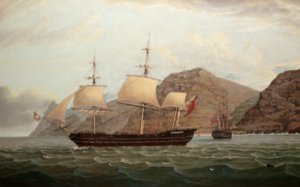
The Ardmori Crown sponsored another expedition further into the Malentine, finding the Southern of Foxhey's two islands. This was followed with the reaction of the "Gibson Settlement" in 1822, which was eventually renamed Port Gibson, and with the town reaching a population of 2,500 less than two years later, it had ratified the early Arco constitutional documents, the Crown recognizing it as a Governorate in 1824. Bellings was quick to appoint Frederick Gibson as the Governorate's first Lieutenant-Governor. Port Gibson would become a major fishing, whaling, and shipbuilding town, and one of Arcerion's most important Western ports. By the mid-1820s, Dunborough had established into a large frontier town. A permanent garrison of several hundred regular and Arcer soldiers, as well as thousands of farmers, settlers, and traders had created a trading town that was a junction between Indigenous and Occidental. This was similar to Dalfearn, which was at the foremost border of the inland Arco territory. Dalfearn itself was still growing and being industrialized, and with only a small dirt road that was easily washed out, was removed from most Arco garrisons and assistance from the Ardmori Crown.
The end of the period prior to the Second Bush War was the establishment of Easthampton as a mining town. Bellings had relinquished the Crown-Governorship in 1825, recalled to Ardmore by the Crown Regent for the purpose of becoming the first Ambassador from Arcerion to Ardmore, representing the increasingly important status of the nation. He was replaced by Lord Rowan Elliot, a landed noble from Ardmore and a sizeable landowner in South Moorden. Elliot's first aim was to expand to the Eastern reaches of the Arcer Heartland, the major key piece of this being a large minining expedition that would culminate with Easthampton's establishment in 1834 as Arcerion's Easternmost settlement.
Second Bush War (1839-1850)
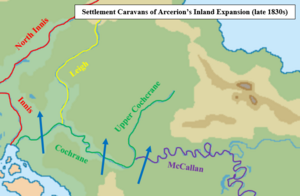
By the outbreak of the Second Bush War, Moorden Governorate was a fully functioning proto-state. It had departments, bureaucracy, and taxation, with shipyards, docks, and wharfs seeing an exponential increase in emigration and commerce month by month. Norham and Foxhey Governorates also had begun to see an increase in the apparatus of the state, and Arcerion's growth and future outlook were positive.
Inland expansion was done via caravans, large groups of several hundred settlers that would take wagons, horses, cattle, and supplies to unsettled lands and attempt to set up new towns and farms to continue to push Arcerion's boundaries. This finally clashed with the Chaxhan tribe, who controlled much of the territory in the Innis River Basin, along the Leigh River, and the area north of the Cochrane River. The remnants of the Chaxhan and Tyrohsa tribes declared a truce and banded together as allies to combat Arcer settlers, raiding and destroying many caravans in the first year of the conflict. The response by Crown-Governor Sir Franklin Wright was to deploy the Army inland in force, to begin counter-raiding, patrolling, and conducting large sweep and clearance operations to force Indigenous tribes out of the new settlement areas.
Initially, the war was inconclusive, as the Allied Tribes withdrew deeper to avoid a large defeat due to their dwindling numbers, as their population's decline had been hastened by interaction with Occidentals and their low resistance to Occidental diseases. Minor gains were made initially, with the Royal Arcerion Regiment moving its battalions to Dalfearn to begin operations there. Wright also sought a royal decree, and was permitted to raise additional regiments by either reconstituting militia units as Regular Army formations, or the creation of new ones (notably the Royal Moorden Regiment in 1849 and the Northlea Rifle Regiment in 1842).
By the end of 1847, reconnaissance by Arco and Ardmori cavalry scouts had made it clear that the Allied Warbands had finished their scouting and raids. Raids along the river had created issues for settlements that were unable to defend themselves, and a series of forts and block houses were constructed between 1845-1848, under the direction of Sir Wright, and by doing so the Allied Indigenous tribes were forced to withdraw further, preventing them from striking deeper into Norham and Moorden governorates. This, combined with armed riverboats and early gunboats, allowed for the quicker transportation of men, weapons, and equipment up the Innis, Leigh, and Cochrane rivers to reinforce major garrisons such as Dalfearn. In the Innis River Basin, the Battle of Dunborough in 1847 by the Northlea Rifle Regiment had destroyed a large Chaxhan warband, and forced them to flee. In pursuit, two battalions of the Northlea Rifle Regiment were trapped and surrounded at Gordon's Farm. Numbering 644 men, the Arcer soldiers defended themselves against War Chieftain Ylo M-K'ahsa, and what is estimated to be over 4,000 Chaxhan warriors at the Battle of Gordon Farm. Surrounded for three days and without relief, until a reinforced battalion from the Royal Arcerion Regiment made it to the battlefield. It would be a pivotal moment in Arcer history, as it was a display of Arco Determinism.
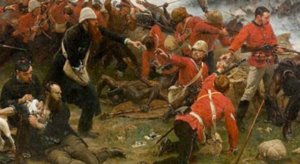
In 1848, a warband of nearly 10,000 Chaxhan warriors descended on Easthampton, and the Royal Arcerion Regiment defended the mining town for over a week, with fierce urban battles and counter-attacks in the mountains occurring. The battle ended in a stalemate however Arco forces held the town and forced a Chaxhan withdrawal, ultimately meaning it was a strategic Arcer victory with Easthampton's survival. 1849 and 1850 saw large clashes between Chaxhan Warbands and Ardmori and Arco regular troops. Along the length of the Upper Cochrane River, the River Campaign saw large clashes between the 14th, 15th, 77th, 81st, and 92nd Regiments of the Foot (Ardmori Army), with support from the Royal Arcerion Regiment, Royal Moorden Regiment (formerly the Arcerion Loyal Militia), and elements of the Northlea Rifle Regiment. Two major battles were fought, resulting in thousands of Indigenous warriors killed, and several hundred of the Royal forces.
In the rear areas, the newly formed Royal Arcerion Constabulary, a paramilitary gendarmerie, was working to investigate smaller raids and thefts, and detain and prosecute smaller warbands of indigenous warriors harassing the populace. This was done under the new Crown Governor, appointed in 1849, and the first natural-born Arcer, Sir George Greene. A career farmer and agricultural businessman, Greene had also served briefly as an officer in the Militia, before resigning his commission to serve as the head of the Arcer Treasury in 1833. Greene would see the Second Bush War through to its end. The war ended shortly after the fourth and final Battle of Cochrane River, where the remaining Chaxhan and Tyrohsa forces were destroyed by the Royal Army, and their war chieftains commited riutal suicide, the new leaders suing for peace and withdrawing their remaining tribes and peoples to the Northern reaches of the Arcer Heartland, in the foothills of the Northumbraeland mountains.
Late Colonial History (1880s-1920s)
Antebellum Period and Economic Boom (1851-1886)
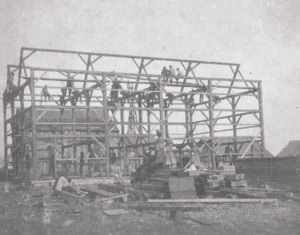
With the conclusion of the Second Bush War, Arcerion had for a second time defended its existence from marauders that had sought to destroy it. This coincided with a decree from the Ardmori Crown establishing Northlea Governorate as Arcerion's fourth province, and the newly arrived Lieutenant-Governor Lord David Barclay appointed by the Crown as its governor. This was a break from convention, as it was unusual for a Lieutenant-Governor not to be recommended by the Crown-Governor, and instead reflected an increasing mistrust of Arcerion's growing levels of independence.
Despite this, the Ardmori Crown continued to grant increasing levels of economic freedom to Arcerion, including the issuing of its own bonds, the creation of its own tax law, as well as allowing some autonomy for the Governorates to create their own legislation at the provincial level. However, Ardmore retained tight control over the federal organs of power, to ensure the colony did not stray away from the Crown. Despite this, Arcerion's booming economy was reflected by the massive increase in shipping to its Southern ports, a heavy increase in trade with Paulastra, and the continual arrival of new Ængles, Gaels, and Gothic peoples who sought a new life and a parcel of land to farm as part of a great migration from Levantia.
During this time Arcerion's population reached over fifteen million. The economy had already outstripped the native Indigenous states, and was rivalled only in South Crona by other Occidental nations such as Alstin and Paulastra. Major exports of wheat, soft and hardwood timber, rye, and spirits helped flood foreign markets with increasing numbers of Arco goods. Discussions even began surrounding the creation of a new Arcer currency.
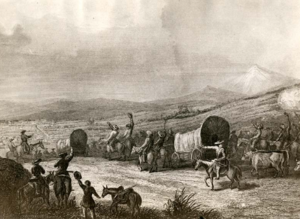
This period was mostly known for the settlement of the Arcer Heartland. Caravans in 1864 and 1870 moved inland along the Leigh and Innis Rivers, pushing forward from Oakham (established in 1839) and Dalfearn. By 1878, the largest Arcer settlement in the Heartland, Presdale, had been established by a group of Gaels resettled from North Ardmore, and Arcerion's footprint in the Heartland was established. By 1888, a caravan from Oakham had Pushed along the North Innis, establishing contact formally for the first time with the Kel-kon'e tribe, who now had been forced to share lands with the Chaxhan tribesemen who ahd continued their withdrawal Northwards each successive generation. Arcer culture had also taken major leaps with the establishment of a nascent national identity, later formalized as Arco Determinism. Folk music, newspapers, parades, and national holidays had begun to take root, and Ængle and Gael traditions mixed with those of the established Arcer citizenry to create a blended national identity. Even the Ænglish language had begun to change with regional dialects in Foxhey and Moorden giving a different accent that was distinctly different from Levantine Ængles.
Industrialization and railways (1886-1898)
With the introduction of the Arco National Railway Service (ANRS) the pace of industrialization in Arcerion increased rapidly. The first rail line was set from Port Hughes in the South to Dunborough in the North, with a new line set up to Easthampton to help ship the vast quantities of iron ore and steel products being manufactured in the town. It was during this time of rapid economic expansion and mass emigration that Crown Governor Sir William Walter James requested permission on Arcerion's centennial birthday to have a special status as a semi-sovereign state. Granted by the Crown Regent in Ardmore, this gave Arcerion control over its own international relations, diplomatic presence, its own sovereign coat of arms, and control over its economic policy. This petition formed the second of three documents that formed the basis for the Arcer constitution.
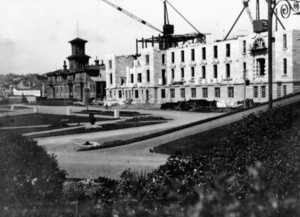
With semi-governance also came the withdrawal of much of the regular Ardmori forces. Multiple regiments of infantry, cavalry, and batteries of artillery were withdrawn, as well as the offices and officers of the Ardmori Crown such as the Crown Treasurer to Arcerion, the Tariff Office, and the Attorney General for Arcerion. In the wake of the Ardmori withdrawal in 1890, Arcer Crown Governor Sir James relinquished his role in a ceremony to Henry Faulkner, a Lord and shipbuilding magnate from Foxhey, a born citizen of Arcerion. James' reasoning was Arcerion now must be ruled by its own people, and Faulkner was the first Crown Governor from Foxhey, and the second naturally-born Arcer to hold the office.
The Confederate Parliament by this time had expanded into a full legislature, and provisions to move the Arcer Senate into a new wing of the building had coincided with planned improvements and upgrades for the building. Rosmore Station in Kurst, the largest railway station and trainyard was seeing daily regular traffic in the thousands, and major corporations from Arco Steel to Foxhey Shipyards were quickly competing at an international level and establishing Arceiron as the dominant Malentine economic power. Proto-states in Kelekona, Titechaxha, and Istrenya were increasingly becoming reliant on Arco trade, and the wharfs and dockyards of Chester-on-Moore and Kurst were overflowing with Levantine ships, especially those of Burgundie, transporting Arcer goods to the Occidental world. However relations with Paulastra, especially concerning the Washakaran Basin, were beginning to cloud over. Diplomatic negotiations over the administration of the small native reserve was increasingly declining, and the strained diplomatic relationship was further damaged with the introduction of the Arcer Pound in 1890, which quickly flooded the Washakaran market, devaluing Paulastran currency and further bringing Washakara closer to Arcerion.
Industrialization in Arcerion varied greatly by Governorate and type. In Moorden, developed factories, manufacturing plants, and raw mineral and mining industries (especially in Easthampton) were the largest shares of the market. Conversely, Northlea and Norham remained mostly agrarian in nature, with grain, rye, and maize increasing in production due to advances in new crop rotation methods, advanced farming machinery, and the creation of grain coops where farmers pooled resources and financed grain elevators and shipping techniques via rail. Foxhey remained largely reliant on maritime sources of economic prosperity such as fishing and ship building, however the federal contracts for the Royal Arcerion Naval Service meant that hundreds of jobs were created with the plans to construct new frigates, ships of the line, and the planned introduction of steam vessels.
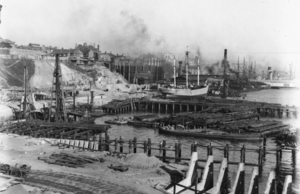
Third Bush War (1898-1904)
RAR battle
First Great War
See: Washakaran Campaign
The Arcer Heartland
Early 20th Century
Ardmori Civil War
Second Great War
See: Cronan Theatre of the Second Great War
Last Bastion of Royal Ardmore
Ardmori diaspora and the great resettlement
Late 20th Century
Fourth Bush War
Polar Explorations and Howland Governorate
Emerging Role in Crona
The Industry of Agriculture
The Arcosphere
Modern History
CSTU
Foreign Policy and South Cronan Leadership
Economic Growth and Polynesian Initiatives
All Old/Partially Canonical
Arcerion was first settled by early Ardmori populations in the 1790s, becoming a recognized and organized colony in the Kingdom of Carna in 1793. In the period that followed, Kurst, Kinnaird, and Chester-on-Moore all grew into prosperous colonial towns, providing jobs and stability in a region that was noted for its shifting political states and reliability of colonial partners. Arco settlers spread quickly to what would become the rolling plains of Northlea governate, taking their pluck and knack for farming and creating vast farming estates, helping to boost the early colony's independence on foreign foodstuffs and goods by increasing tis self-reliance. By the 1830s, expansion into the mountains had begun, and the small mining town of Easthampton had discovered the resources that would help solidify Moorden's future as a raw ore and industrial processing center in Crona. Gained economic and interior governance independence in the 1880s. Full independence just before the Great War. A series of border skirmishes with their indigenous neighbours to the North would be a constant, with Arco militia forces taking over the bulk of the country's policing and security operations by the 1860s. Carnish influence continued to exist in the capital, and Arco settlers still proudly identified their loyalty to the crown and identified as citizens of Carna until they were granted self-rule and governance in 1886. By this time, there was only token presence of Carnish tax inspectors, administrators, and politicians, with the vast majority of government positions having been taken over by Arcer citizens. It was roughly this time that Carna began to permit the issuance of passport-equivalent paperwork and allowed Arcerion to have its own self-determined foreign policy, beginning with the fledgling emergence of Arcerion's Foreign Office, which first began as the Foreign Secretary and their staff.
Self governance brought its own series of challenges as Arcerion grappled with instituting its own public services and administrations. Arcerion specifically focused on the overhaul of its Parliament, resulting in the legislature moving away from a colonial model to a two-tiered system with an upper and lower house. By moving the lower-house to the Provincial/Governate level, the hope was that the creep of federal power would not detract from the Confederation as a whole. The result was a decentralized approach to governance allowed for individual governates to grow, with the assurance that the collective would support in times of need. By the late 1890s, increased border skirmishes required the country's first 'sovereign' or 'independent' deployment of military forces to Northlea and what was then-Northlea's Western portions, and what would eventually become Oakham governate. Multiple Arcer infantry, cavalry, and the first light artillery formations were sent North to combat the growing restlessness of indigenous populations who had begun to attack and murder families of Arcer farmers as they ventured out into the Cronan wilds to stake their claim. This period, The Border Wars, would help form part of modern (2000s) Arco policy towards Kelekona and Titechaxha, wherein the borders are rigorously patrolled and monitored.
The addition of Carna granting limited independence for economics and foreign politics meant Arcerion was finally able to unilaterally negotiate in Southern Crona, establishing relationships early with the two Kiravian colonies there, the Cape and Paulastra. Relations were generally friendly with both, as the hardships of settling Southern Crona was generally a bonding tenet of foreign policy on the continent. As the decades continued the economy continued to grow, with Moorden's raw iron ore exports shipped through the Songun Straits out to the old world, and Arcer foodstuffs from Northlea governate slowly becoming more prevalent in markets and groceries through Southern Crona. Roads and rail systems began to be created under new infrastructure projects, as early politicians used the limited federal taxes and income to benefit the average Arco citizen. The establishment of the Arco National Railway Service (ANRS) in 1886 resulted in the nation's first heavy commercial rail line from the Kinnaird-Kurst areas to Easthampton to carry raw resources to ports for transport to manufacturing facilities abroad.